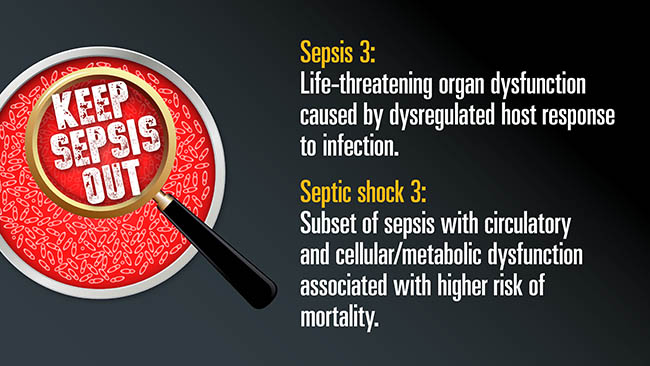In the fight against sepsis at Nebraska Medicine, the numbers reveal progress in protecting patients. New initiatives are coming this fall to support the momentum.
An important change is coming in November: the adoption of a new, updated definition of sepsis.
“What was severe sepsis is now defined as sepsis,” said Micah Beachy, D.O., UNMC associate professor of internal medicine and medical director, clinical effectiveness at Nebraska Medicine. “Using the same terms will be important to appropriately care for our patients.”
 |
Alongside the new definitions, the clinical effectiveness and sepsis operational teams are launching a new sepsis early warning system within One Chart and new nurse-driven protocols in November.
“The warning system will replace the current alert and aims to be more specific,” Dr. Beachy said.
Sepsis operation team members
- Kelly Cawcutt, M.D.
- Dave Gannon, M.D.
- Trevor Vanschooneveld, M.D.
- Justin Birge, M.D.
- Rajendra Karnatak, M.B.B.S.
- Brandi Johansen
- Brandon Jordan
- Lisa Ablan
- Michelle Schulte
- Melanie Tuamoheloa
- Greg Peitz, Pharm.D.
- Katie Circo
“By improving our surveillance tool, we can reduce the number of false alerts,” said Kelly Cawcutt, M.D., assistant professor in the division of infectious diseases at UNMC. “Once the suspicion for sepsis is identified, it’s important for the clinical team to work quickly as mortality increases with every hour of delayed treatment. Allowing nurses to initiate the developed protocol as they notify the provider will help reduce delays.”
Video: Drs. Beachy and Cawcutt discuss the med center’s efforts to fight sepsis.
The warning system will alert a nurse in One Chart when a patient is at an increased risk for sepsis.
“The tool will analyze various data points in the patient’s chart to predict patients who are at an elevated risk of developing sepsis,” said Charlotte Brewer, lead, clinical informatics at Nebraska Medicine.
Depending on the score, the system will prompt the nurse to screen for infection and if indicated, the nurse will be prompted to initiate the protocol.
The nurse-driven protocol empowers a nurse to initiate screening labs and fluids while notifying the provider simultaneously. Nurses at Nebraska Medicine-Bellevue and Nebraska Medical Center will learn about the changes in October during a required education module in Apollo.
“This will require a culture change for nurses to take these steps,” said Michelle Schulte, nursing professional practice and development specialist, 6 and 7 Lied. “It’s important for nurses to feel confident and know they’re supported when placing the protocol. This is best practice.”
The clinical effectiveness and sepsis operational teams are hoping the combined results of a clearer definition, the new warning system and nurse-driven protocol will have an important impact on sepsis mortality.
Learn more about early treatment guidelines for sepsis in this video.

Great job saving more lives!
What about patients who survive Sepsis but have PSS or MODs there is no place for help with the after effects from Sepsis, Septic Shock, there is no support groups/clinics
This needs to change